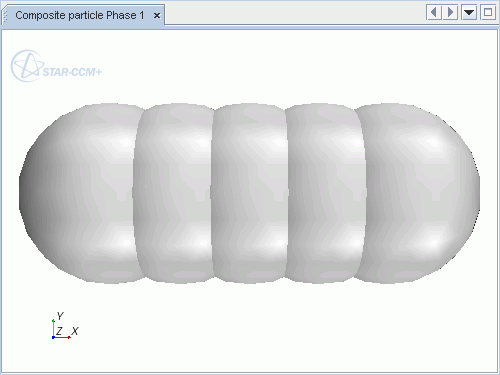Composite Particles Model Reference
The Composite Particles model uses multiple shapes (spheres) to represent non-spherical particles. The shapes are fixed together and do not separate during the simulation.
If you wish to model particle bonds that can break, select the Particle Clumps model.
The image below shows an example of a composite particle that uses five spheres to represent its shape.

| Provided By | |||
| Example Node Path | |||
| Requires |
Under
:
Under
:
|
||
| Properties | Key properties are: Number of Spheres, Moment of Inertia Scaling, Projected Property Resolution. See Composite Particles Properties. | ||
| Specific Right-Click Actions | See Composite Particles Right-Click Actions. | ||
| Activates | Model Controls (child nodes) |
|
|
| Field Functions | Particle Projected Area, Particle Projected Length | ||
Composite Particles Right-Click Actions
- Create Shape
- Creates (or re-creates) a composite particle that is based on the selected shape, using the number of spheres currently specified by the Number of Sphere to Generate property.
- Update Properties
- Updates the particle properties that are based upon the current geometry, that is, the user-defined shapes.
- Show Model
- Displays a representation of the particle in the Graphics window.
Composite Particles Properties
- Principal Moment of Inertia
- Read-only property reporting the product of Principal Moment of Inertia and Moment of Inertia Scaling. Not available with Particle Clumps.
- Area
- Read-only property reporting the area of the particle.
- Volume
- Read-only property reporting the volume of the particle.
- Sphericity
- Read-only property reporting the sphericity of the particle. This property is used when calculating the Haider and Levenspiel drag coefficient (see Eqn. (2977)).
- Number of Spheres
- Read-only property reporting the number of spheres to use when filling a part. See Creating Sphere-Filled Parts.
- Moment of Inertia Scaling
-
Provides a scaling factor for each axis of the moment of inertia of the particle. This can be used to simulate effects such as uneven distribution of mass within the particle, or the dynamical response of a non-spherical particle. The scaling factor has an allowed range on each axis of 1E-2 to 1E5. The default value is [1.0, 1.0, 1.0].
- Principal Moments of Inertia as Scaled
- Read-only property reporting the product of Principal Moment of Inertia and Moment of Inertia Scaling. Not available with Particle Clumps.
- Projected Property Resolution
- Specifies the degree of resolution for particle cross-section and length relative to the direction of flow in the particle's frame of reference, expressed as an integer ranging from 0 to 5. The default value is 0. This is an expert property.
First, the projected area is estimated in several directions by numerical integration. Then a closer estimate is calculated for the selected direction by interpolating between the three nearest directions from the first step.
Raise the value above the default of 0 when fluid drag is important. Computational cost increases directly with the value. In most cases, a value of 1 or 2 is sufficient.
Composite Particles Input Node
Use the Input manager node to select the input method.
- Method
-
- Manually
- Inserts the Manually node under Input. This node has no properties. Right-click and select New to introduce a new Sphere node. See Working with Individually Composed Shapes.
- Part
- Inserts the
Part node under
Input, with the following properties:
- Part
- The part selected to be filled with spheres. See Working with Sphere-Filled Parts.
- Number of Spheres to Generate
- The number of spheres to use when filling a part. See Creating Sphere-Filled Parts.
- Table
- Inserts the
Table node under
Input. This method allows you to load a particle shape from a pre-existing table. Each table entry describes one of the spheres in the composite particle. The node has the following properties:
- Table
- The name of an input table that has already loaded into .
- X Coordinate
- The name of the table column for the x coordinate of the sphere center.
- Y Coordinate
- The name of the table column for the y coordinate of the sphere center.
- Z Coordinate
- The name of the table column for the z coordinate of the sphere center.
- Radius
- The name of the table column for the sphere radius.
- Create Shape
- Creates (or re-creates) a composite particle that is based on the selected shape, using the number of spheres currently specified by the Number of Sphere to Generate property.
- Update Properties
- Updates the particle properties that are based upon the current geometry, that is, the user-defined shapes.
- Show Model
- Displays a representation of the particle in the Graphics window.